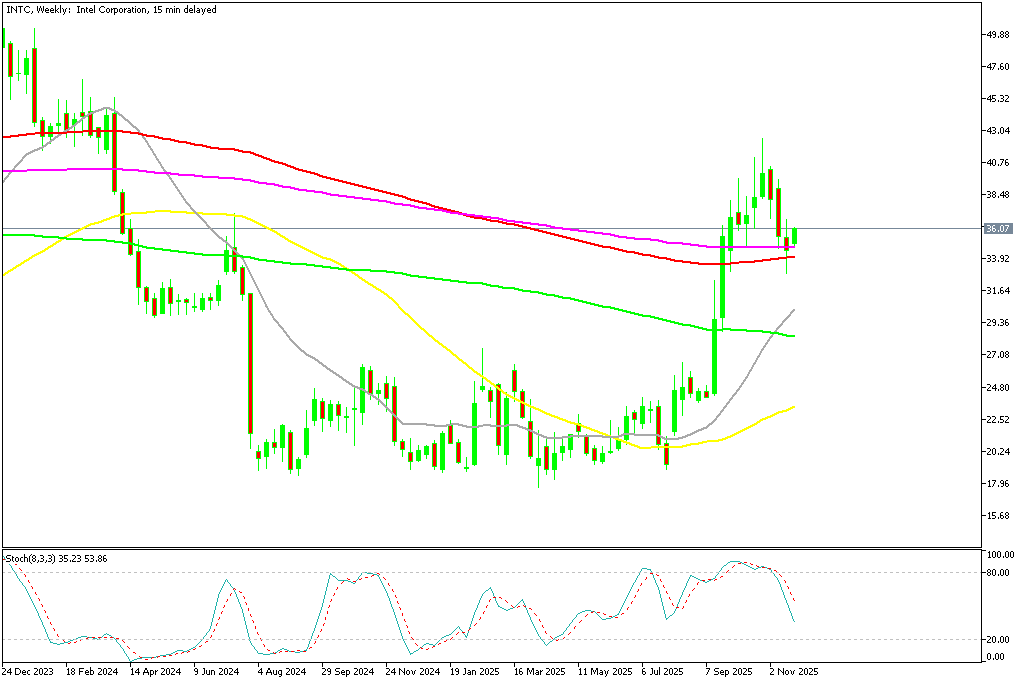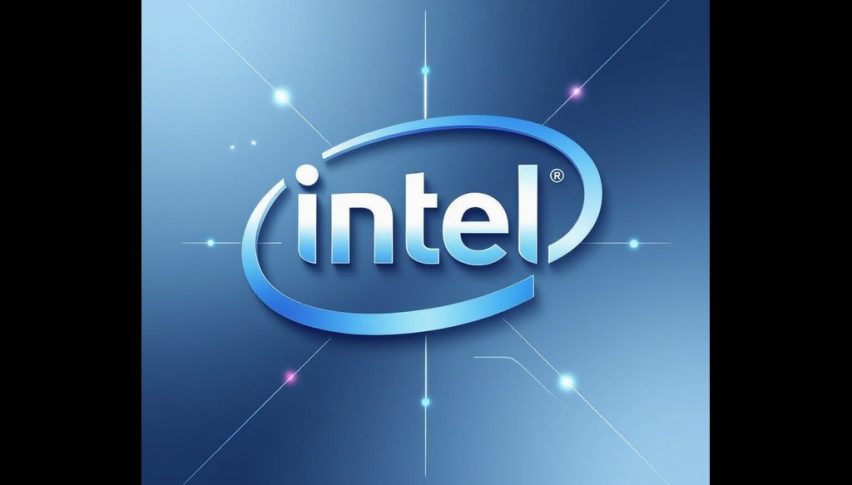Intel’s Comeback Gains Strength as INTC Stock Rebounds Off $33 Support
After a turbulent November that pushed shares sharply lower, Intel has begun to stabilise again as technical support, leadership changes...

Quick overview
- Intel has begun to stabilize after a turbulent November, with improved sentiment around its long-term recovery prospects.
- Key leadership changes and strong technical support have contributed to a rebound in Intel's stock price, which recently climbed above $35.
- Intel's strategic alignment with U.S. government initiatives and partnerships with major tech companies enhances its competitive position in the semiconductor industry.
- Despite recent challenges, Intel's focus on innovation and manufacturing is seen as a significant advantage over competitors like AMD.
Live INTC Chart
[[INTC-graph]]Following a stormy November that caused shares to plummet, Intel has started to stabilize once more as trust in its long-term recovery story is restored by technical support, leadership changes, and historic U.S. government backing.
Intel Rebuilds Strength After November Turbulence
Following a sustained pullback through most of November, Intel has begun to regain stability, with sentiment improving around the stock as investors re-embrace its long-term turnaround prospects. Solid technical support, renewed policy momentum, and a sharper focus from leadership have helped turn the tone more constructive once again.
Intel (NASDAQ: INTC) retreated nearly $10 from the $42.45 resistance zone as broader markets cooled. Shifting expectations around interest rates and a temporary slowdown in enthusiasm for AI and tech-related stocks created a risk-off environment that weighed heavily on the semiconductor sector. By Friday, Intel shares slipped below $33, as sector downgrades and speculation around future AI hardware demand unsettled investors.
However, that weakness proved brief.
Following dovish comments from the Federal Reserve, rate-cut expectations for December increased, lifting overall market sentiment. Intel responded quickly, rebounding above $35 and climbing toward $36 as buying pressure returned. The speed of the recovery highlighted that underlying belief in Intel’s revival has not disappeared — it was merely tested by short-term fear and uncertainty.
$42.50 Remains the Key Hurdle For A Larger Bullish Breakout
Intel’s rally to around $42.50 in late October marked the company’s highest level in more than a year. That move symbolised the strength of its multi-month rebound from the August lows below $19. Although the price was unable to break through this major technical ceiling on the first attempt, the retreat that followed has remained orderly rather than chaotic.
INTC Chart Weekly – The 200 SMA Turns Into Support
Importantly, support developed around key moving averages near $33, reinforcing this zone as a structural floor. Even when news emerged that Intel may not be part of OpenAI’s immediate hardware plans, the market reaction was driven more by emotion than by fundamentals. Intel’s investments in advanced manufacturing processes, server platforms, and AI-optimised architecture remain intact and continue to attract interest from both enterprise and government customers.
Competitive Dynamics Shift in Intel’s Favour
While Intel works to restore its technological and operational leadership, close competitor AMD is beginning to experience slowing momentum. Despite AMD delivering stronger shipments in Q3 2025, some analysts suggest the company may be nearing a cyclical peak. Margins have compressed, inventory conditions are fragile, and the excitement that once surrounded its data-centre and AI expansion has cooled.
In contrast, Intel is becoming increasingly aligned with long-term structural trends — especially the strategic push to re-establish semiconductor manufacturing within the United States and allied nations. This positioning provides Intel with advantages that go beyond short-term sales metrics.
Leadership Moves Reinforce Strategic Focus
Another confidence boost arrived on November 10, when Intel announced that CEO Lip-Bu Tan would take direct oversight of the Chip and Advanced Technologies Groups. Rather than creating uncertainty, the move was interpreted as a sign of commitment to innovation and engineering excellence. It also followed the departure of CTO Sachin Katti to OpenAI, which created an opportunity for Intel to refocus and streamline internal decision-making.
At the same time, Intel stands as one of the largest beneficiaries of the U.S. CHIPS Act, having secured nearly $16 billion in incentives and financing. This powerful alignment with government policy has played a decisive role in the rebound from the stock’s sub-$19 level in August to above $40 in October.
Technical Base Supports the Bigger Picture
From a technical standpoint, Intel’s rally toward $42.50 ran directly into the 100-month simple moving average, a level that historically acts as formidable resistance. The subsequent correction toward $33 overlaps with several converging supports, including the 200-SMA on the longer-term chart.
Dip buyers have already stepped in around this zone, and many technicians now view $32–$33 as an accumulation area should volatility return. A confirmed breakout above $42.50 would represent a major technical victory and could mark the beginning of a new long-term bullish phase.
Strategic Partnerships Strengthen Intel’s Role
Despite price swings, Intel continues to attract attention from global technology leaders. Reports indicate that companies such as Apple, SoftBank, Nvidia, and others are exploring broader cooperation with Intel in areas ranging from next-generation supply chains to advanced chip design. These potential partnerships underscore Intel’s increasing importance in a world focused on supply security and geopolitical resilience.
AMD’s heavier reliance on external foundries, meanwhile, leaves it more exposed to supply disruptions and aggressive pricing pressure.
In an industry driven by scale, sovereignty, and long-term planning, Intel’s integrated U.S-based manufacturing model is becoming a strategic asset once again — and the market is beginning to reflect that reality.
- Check out our free forex signals
- Follow the top economic events on FX Leaders economic calendar
- Trade better, discover more Forex Trading Strategies
- Open a FREE Trading Account


